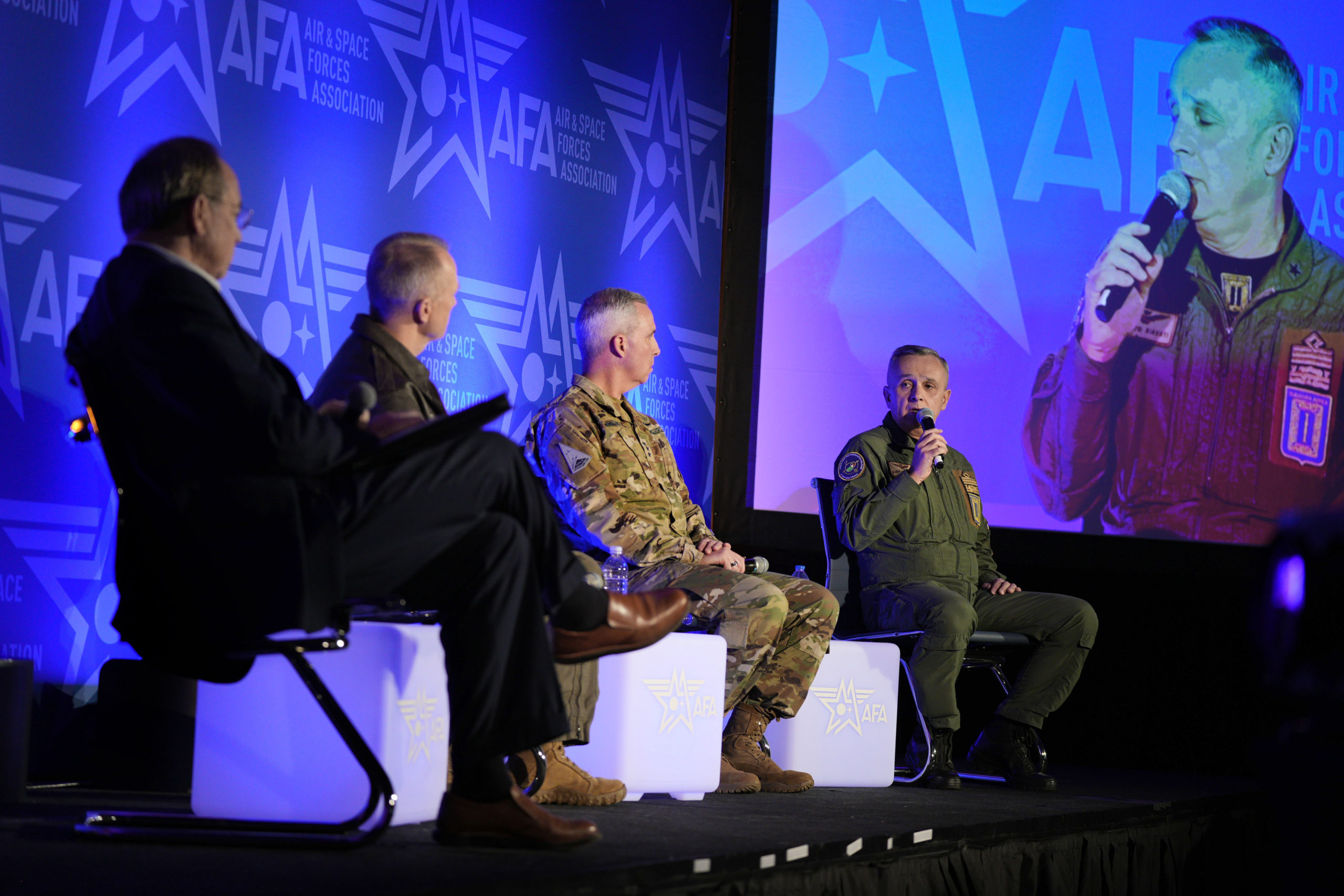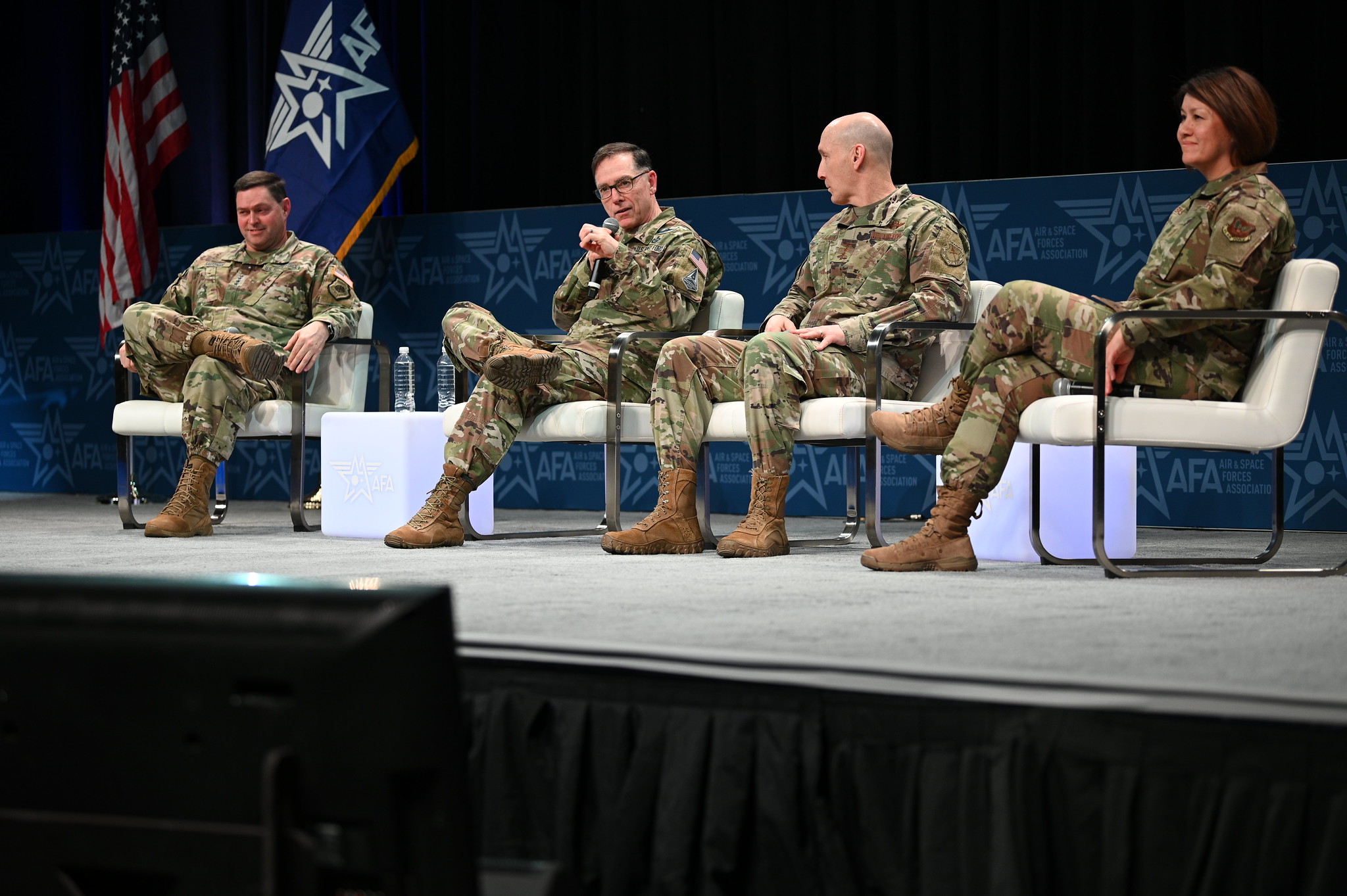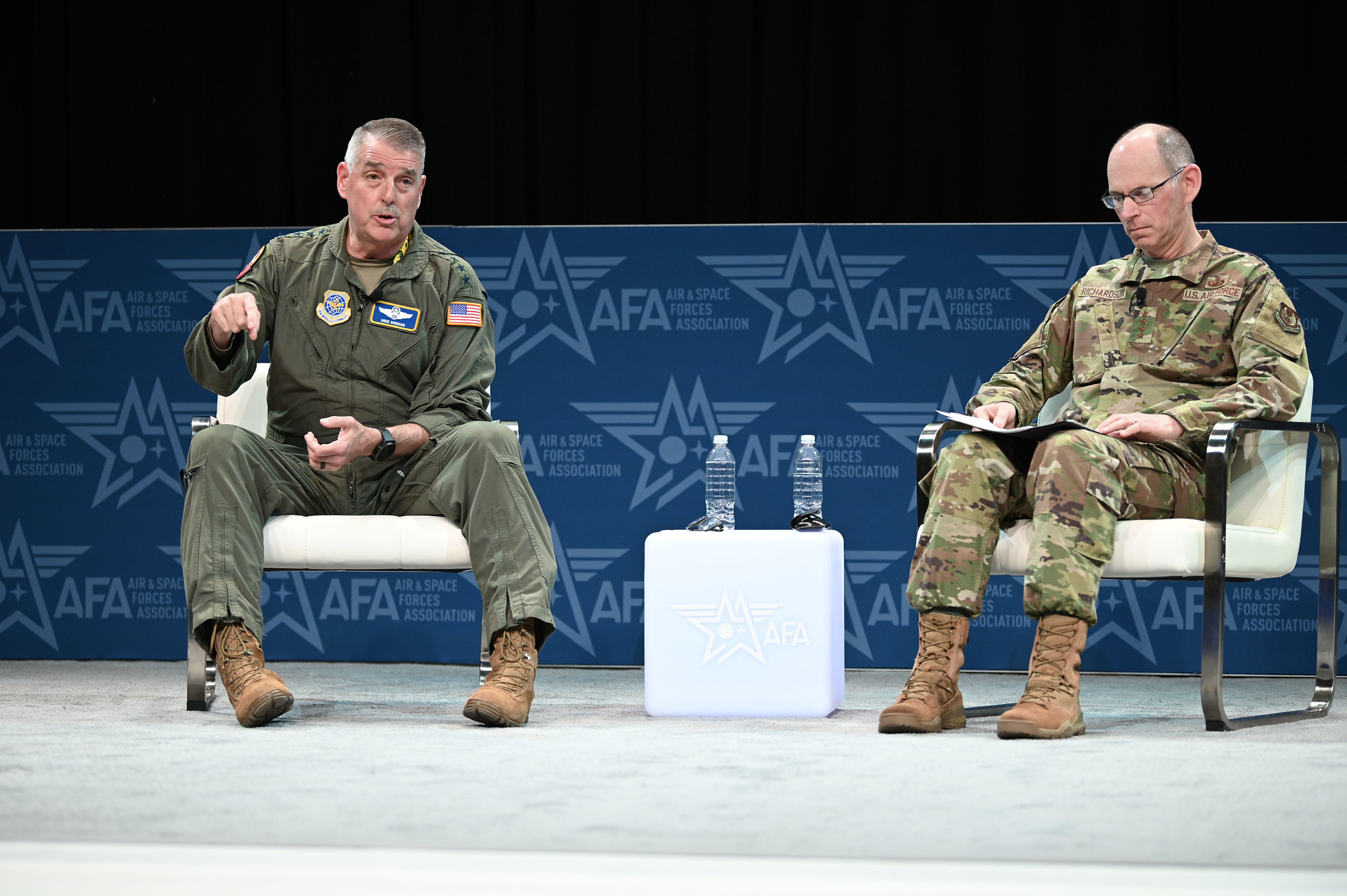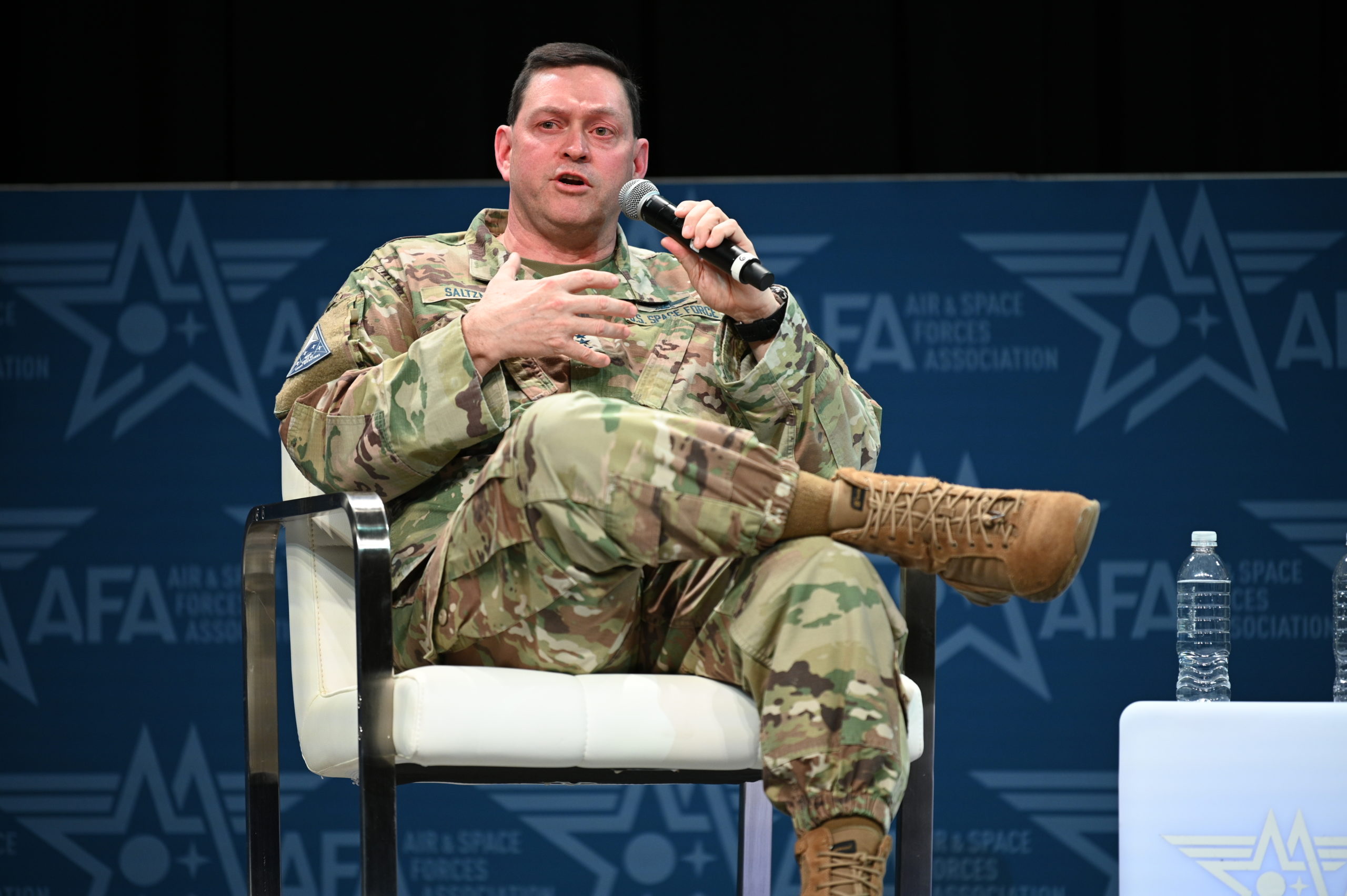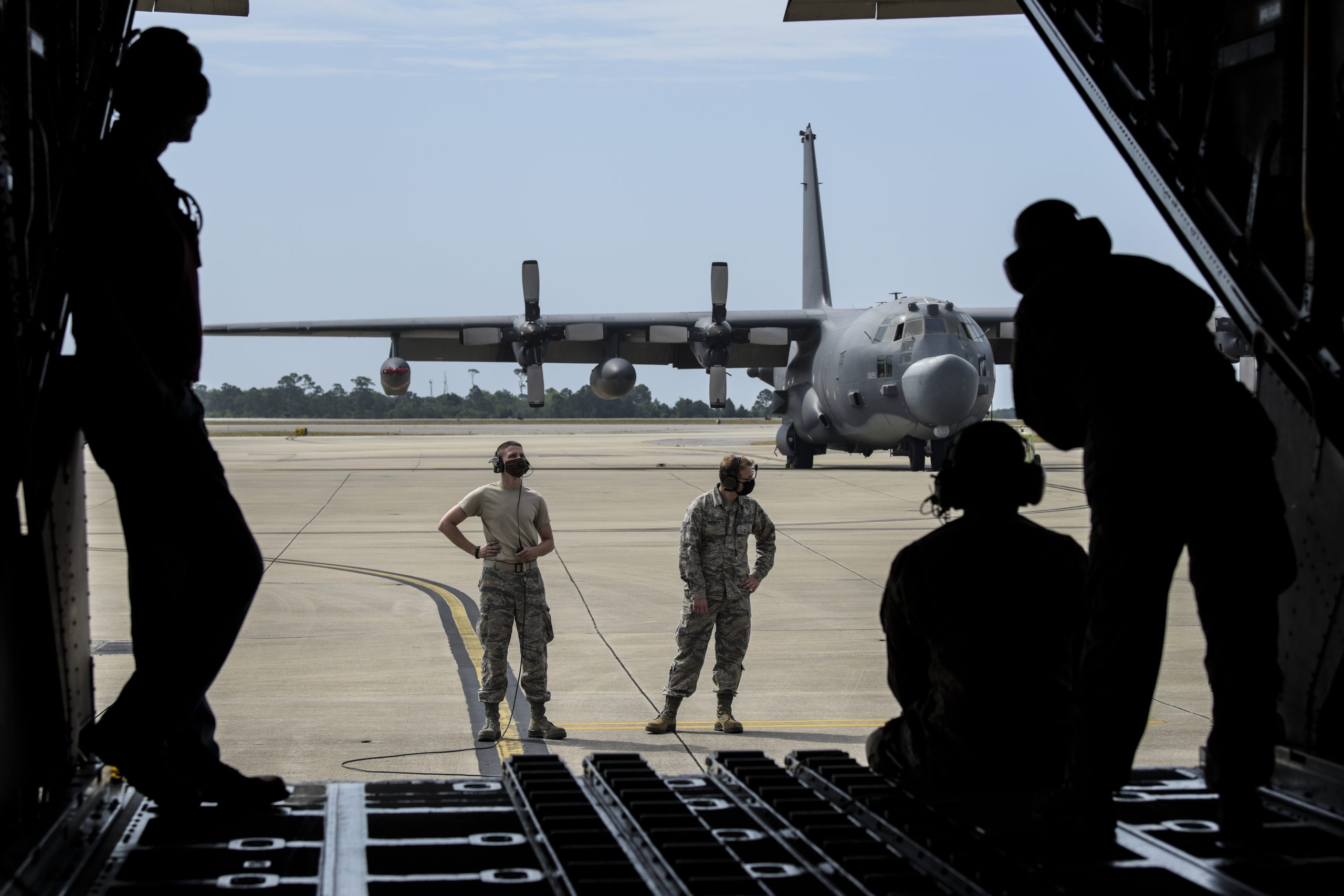Retired Lt. Gen. David A. Deptula, dean of the Mitchell Institute for Aerospace Studies, moderated a panel with Gen. Mark D. Kelly, commander of Air Combat Command; Lt. Gen. Stephen N. Whiting, commander of Space Operations Command; and Lt. Gen. Alberto Biavati, Italian Air Force Operational Forces Commander on the need to integrate across services and partners to better target threats on March 7, 2023, at the AFA Warfare Symposium. Watch the video or read the transcript below.
Lt. Gen. David A. Deptula, USAF (Ret.):
Okay. I guess we’re ready to go. I guess this is a pretty popular panel, because of all of our panelists. Sorry for those of you who have to stand on the sides and in the back. I’ll make sure the leadership gets the word to give us a bigger space next year.
I’m Dave Deptula, Dean of the Mitchell Institute for Aerospace Power Studies. As you can already tell, we’re really pleased today to host General Mark Kelly, Commander of Air Combat Command, Lieutenant General Steven Whiting, the Commander at Space Operations Command, and Lieutenant General Biavati, the Air Operational Forces Commander for the Italian Air Force. Welcome, you all, to our forum today.
As you can see, there’s a lot of interest in the topic, and what I’d like to do is just give a little bit of a brief introduction. Now, as we move toward realizing this notion of joint all-domain, command and control, we need to start looking at how the war fighting capabilities in different domains can be better integrated to target and defeat the wide array of threats facing us.
Whether that be air, land, sea, cyber, they’ve always worked better, or at least the people in them have worked better, when they’re integrated to overcome our threats, and space is no different. We need to move away from the idea of de-confliction of forces to a construct focused on getting the right capability to the right place at the right time, or better said, integration of available forces to achieve desired effects in the battle space. That includes integrating the capabilities of our allies and partners. You know we’ve got some key players here. I’m really pleased that General Kelly was able to join us today. As the commander of Air Combat Command, he’s got an understanding like none other on how to affect mission results with the combat air forces under his command. We’re really looking forward what you have to say today, General Kelly.
I’m also glad to welcome Lieutenant General Whiting, because as commander of Space Operations Command, he brings an insight into the space capabilities that underpin all our combat operations. It’s great to have you here too, sir. Finally, I’m happy to introduce Lieutenant General Biavati of the Italian Air Force as the Air Operational Forces Commander for the Italian Air Force. He works really closely with US air forces in Europe and our other NATO allies to ensure that we have a credible and combat ready force in Europe. He provides an important voice as an ally and a partner helping us execute our missions in a truly collaborative way. Thank you all for joining us. What we’re going to do to start off is to give you an opportunity to speak to the subject today. With that, I’ll turn it over to General Kelly and then we’ll just go right down the line.
Gen. Mark D. Kelly:
Okay. Well, great. Well, thanks. Appreciate the invite and appreciate the crowd. I really appreciate my teammates up here. It’s a great optic that we don’t do any event that’s truly hard by ourselves. It takes other services, other domains, other allies and partners, especially when you start talking about targeting in any sense. When I got the email that I was assigned to this panel, Every Threat a Target, I thought it was a bold statement. It doesn’t matter if it’s ACC or Space Force or Navy or our allies or partners, our army. It doesn’t matter who it is. If somebody makes the statement every threat’s at targeted, we need to be wide-eyed that you can call every threat at target, but not every target is targetable easily. That’s a key part that our half A26 and the experts in 16th Air Force go through every single day.
In Alberto’s world, every one of the World Cups soccer goals is a target. In our world, every end zone is a target and every NHL goal is a target. If you’re going to actually get there, it takes an incredible amount of strategy, teamwork, coaching, talent, effort and all that, along with some violence, doesn’t guarantee you’re going to get there. We have to be wide-eyed how hard this is and how professional the Airmen we have and Guardians across the enterprise are, that do this type of mission. Before we make a target actually targetable, first we have to find it and then we have to fix it and then we have to track it. I was talking to John Van Herk yesterday if you were able to attend his speech. I chatted with him for five minutes afterwards and I’ll just segue off of a couple of the comments he made to me.
You heard in his thing, every day or at least every few days, he gets an update on the Russian guided missile submarine, the Severodvinsk. That’s a hard target to find. If you find it, it’s tough to fix in terms of depth. If you do find it and fix it, then to continue tracking it when it runs rather quiet is tough business. Even the Russians themselves, when they wake up every day, they would consider one of their threats the US HIMARS. Very difficult to find. If you find it, very difficult to fix and then it moves. That’s what the H and the I and the M stands for, highly mobile. Very difficult to find, fix, and track these targets that are truly the ones we want to locate. If you get to that stage, well then you’ve got to have a legal clearance to engage something.
For example, again, Gen. VanHerck, I’ll just use his day-to-day engagements. When the ACC launched F-22s to shoot down the balloon off the East Coast at 65,000 feet, they did so because we had found it, we had fixed it, we tracked it, and we had engagement authority. If that balloon would’ve been 62 miles instead of 62,000 feet, it would’ve legally been in space. We would not have a legal recourse to execute that engagement. North Koreans put their MIG base in China during the Korean War, because they wanted to make sure we had a legal hurdle to get through to get to that. Again, not so easy. Then you have to have some capability. Our air domain players, when they go on offense, they’ve got to go through a pretty thick nest of sensors and weapons to get to targets that are heavily defended.
When we’re on the defense or we’re trying to defend our bases, obviously some of the weapons coming at them, the number of missiles coming at them, especially if they’re hypersonic, those are very, very tough targets to make targetable. Again, a very tough business. When you get to the very end of it, again John Van Herk’s lane, you can have the find, the fix, the tracking, you can have engagement authority, you can have the capability.
Like for example, he’s charged, as he mentioned yesterday, with missile defense of the US mainly against North Korea, because he’s got unclassified number 44 ground base interceptors to execute that mission. That does not cover what a peer adversary could throw at this nation. Again, thanks for letting me be on this panel, Every Threat a Target. Just keep in mind, not every threat is targetable. It takes an incredible enterprise of professional Airmen and Guardians and it takes some really methodical planning and execution to get to the end game. Thanks, again.
Lt. Gen. Stephen N. Whiting:
General Deptula, thanks for the invite to be here. It’s great to be here with General Kelly and General Biavati. You said it very well to begin with. Space underpins everything we do in the military. This is a very sophisticated audience and I won’t go through trying to convince you of that fact, but there are some implications that flow out of that fact. Number one is the joint force has been sized, assuming it will have access to our space capabilities through all levels of conflict. We don’t have a force structure across any of our services to fight without access to those capabilities. Now there’s a whole host of technologies that have gone into the size of our force structure for the Air Force, to include stealth technology, jet aircraft technology, global mobility and airlift, and tanking, but without space, we can’t unhinge from terrestrial networks and operate around the globe with command and control.
We can’t operate without knowing what’s over the next hill through intelligence, without being highly precise anywhere we are on the planet. For the Space Force, that means it is our moral responsibility to the rest of the joint force that we continue to provide you those effects that make you more lethal and more effective across all levels of threat. That’s one of the reasons we have a Space Force, is to make sure we can now do that across all of these levels of threat. Of course, the environment we find ourselves in today is more congested and contested. On the congested side, just in the last three years, we’ve seen a 90% increase in the number of trackable objects on orbit. That number is up to about 48,000 right now and that’s gone up for a few reasons. One are the mega constellations like Starlink that we’ve seen be so effective here over the last year in the European theater.
It’s also the Russian ASAT test of a little over 15 or 16 months ago. Highly unprofessional, left 1500 pieces of long-lived debris. We’ve had some other breakups unrelated to that and now we have some better sensors that are helping us track smaller and smaller pieces on orbit. There’s a lot more things now in our environment we have to operate around and while that’s concerning, what’s really concerning are these threats from irreversible up to reversible, direct-ascent ASATs, lasers, on orbit, co-orbital ASATs. All of that we now have to deal with.
As we think about why we have to worry about targeting in the US Space Force, now we have to be able to hold those counterspace capabilities from red at risk and then hold red at risk, as well as they think how they want to use space to get after attacking us potentially. I look forward to discussing some of those issues here over the next 30 minutes or so.
Lt. Gen. Alberto Biavati:
Good morning, or actually, good afternoon to everyone. I would like first to thank General Deptula and the Air and Space Forces Association, The Mitchell Institute for this invitation. It’s a honor for the Italian Air Force to be here today, represented by me, and for me personally is a pride and a pleasure to be here with you. Here in just three weeks, we are going to celebrate our centenary. We are one of the oldest Air Forces in the world. On the 28th of March, we will become 100, but we feel terribly young, not like I do. I’m part of the last 40 of this 100 years and therefore, I feel pretty old. The only good thing is that here next to me sits one of the instructors that I found at Sheppard when I went through pilot training. That gives me at least a little bit of relief on my age.
What are we going to do on this centenary is to remind ourselves first and all our fellow citizens what the Italian Air Force has done in this 100 years and how we came to this point. We came to this point with a lot of losses, a lot of comrades that have fallen in war and in peacetime. We have come to a set of capabilities that I suppose is well rated all over NATO. NATO has many times recognized the capabilities that Italy is bringing to the fight. We are also setting up the next 15, 20 years with the new document that our chief of staff issued some months ago, in which we set the pace for the future. Our pace for the future is exactly the will to meet every threat possibly as a target by developing all the capabilities that we have already developed in the last 20 years in which we had a quantum leap, in my opinion, in development and adding all those capabilities that we have not yet in our inventory.
To do that, we need you. We need the United States Air Force and I make a plea here. We have always been in a very good relations except a very significant but brief time in the previous century. We have always been on the same side, defending the same values, and defending the same free world. We still need your help. We need your help in giving us the possibility to continue training our pilots in [inaudible 00:13:46]. We need to spin up our force and without your support in [inaudible 00:13:52], we won’t be able to do it. We need your industrial base to continue support our fleets like the C-130, the transition to the block five and the predator.
We need your support in training together with us. Lately, we trained in Falcon Strike in the southern part of Italy. We set up an operational training infrastructure that is one of a kind, where you came and trained with us. We help you out with all the American bases that are located in Italy. I think probably we’re the country in Europe with the most American bases. We need your help, because we need to continue our improvement that has brought us to this point that makes us very, very proud.
Lt. Gen. David A. Deptula, USAF (Ret.):
Well, thank you very much, all of you, for those initial insights. I’m thinking as General Biavati was talking … first, congratulations on 100 years, but the first bomb from an airplane, and the historians in the audience would know this, was dropped by an Italian in 1911. That was a long time ago. This is kind of a pertinent to our topic today, but the guidance for that hand grenade that was dropped over the side is a little bit different than what we rely on today with our space-based assets. First question to General Kelly, Air Force targeting doctrine makes a number of key points and specifically it states that targeting is not just about delivering kinetic weapons, but determining the best way to achieve desired effects. Could you walk us through what that means for your approach to targeting threats in a contested environment?
Gen. Mark D. Kelly:
Yeah. No, thanks. I appreciate it. I just got back a week ago from Ramstein, where a whole bunch of ACC airman working in the different squadrons there and their operations center and they’re doing cyber and they’re doing targeting and they’re doing unbelievable work. I wish we could skiff up this place and I could tell you everything they’re doing, because it’s unbelievable work that they’re doing, but it’s mostly in the non-kinetic realm. Frankly, the more contested it gets … and I believe it was in the earlier panel with Joe Latterback and company. The comment was made about how many nautical miles from the particular pier coast, it starts getting dangerous.
Well, that basically is a huge demand signal of you better get your non-kinetics in order before your kinetics even think about going anywhere. Frankly, when Joe Hawk was 16th Air Force commander and now John Kennedy, both the same discussion I had with each one of them as they were in 16th Air Force, and that is 16th Air Force, that information warfare set of experts really needs to be the conscience of the United States Air Force of taking us from a service that has been very, very physical oriented for many, many years and take us a little bit to the cognitive. Not hard to starboard, but we’ve we got to start migrating that way. We’ve been a very physical focused to cognitive, very kinetic focused to non-kinetic, very conflict focused to non-kinetic. Also, we’d like to say we’re digital, but they need to take us there. We’re still very, very analog as much as we’d like to say it.
As far as the non-kinetic and where I sit in ACC, growing up a small airplane guy, one of my biggest efforts, if not my biggest efforts is frankly EC-37 and every electromagnetic spectrum piece of equipment we have. As Joe Montgomery from our British allies said years ago, if we lose the war in the air, we’ll lose the war, and we’ll lose it quickly.
I would say today, if we lose the war in the electromagnetic spectrum, we’re going to lose the war and we’re going to lose it quickly. It’s those non-kinetic experts that take us first and foremost out the door. Many of our 72 hour ATO cycles don’t have non-kinetics as step one. Sometimes they have it as step 10 or step 20. It needs to migrate more to step one. We need to figure out what they can do early on before we start putting people at further risk. Sometimes now they have the best avenue and sometimes our allies have some capabilities and some authorities that outstrip our own. We can’t overstate the capability of our non-kinetic and the talent of our non-kinetic Airmen. Thanks.
Lt. Gen. David A. Deptula, USAF (Ret.):
Awesome. As a bit of a follow on, when we take a look at joint all-domain command and control as a means, what organized train and equip changes, adjustments, whatever do you see out there to implement or make JADC-2 a reality?
Gen. Mark D. Kelly:
Well, the big thing is I would again reference my partners up here on this stage is it needs to be collaborative in every sense of the word. Collaborative, frankly, means trust to a simple aviator. If we’re going to have trust, first and foremost, you have to trust the architecture and the network you’re operating on and your own system. You can have enterprise IT without doing JADC-2, but you can’t have JADC-2 without your enterprise sorted out. You’ve got to, first and foremost, trust the network you’re on. Then it was actually again in the previous discussion that we had in here. That is you have to trust the fine folks that are on the network. I think as far as an organize, train, equip, I think it’s really more organize, train, equip, and policy.
The policy, frankly, outstrips ACC. I’d call it what they referred to earlier as a data strategy, which again is, how are we going to standardize the data, how are we going to secure it, and how are we going to share it. When one of Alberto’s F-35s pushes something onto a network of a USS F-35, or a US AAC or a US E-37 or whatever the case may be, or a space sensor pushes something on the network, there shouldn’t be any ambiguity or me wondering, I wonder if Alberto’s team converted kilometers to miles and feet, et cetera. We should know. They’re on the net, that means they’re on our data strategy, which means they’re on our data standards, which means they’re on our data security. They’re sharing it, because they’ve met that high level of criteria and there should be no ambiguity. We can’t wait and wonder, we are the rate limit of machine speeds of the humans. We’ve got to make sure the stuff that’s provided to us is ready to go and so these teammates are ready to go. Thanks.
Lt. Gen. David A. Deptula, USAF (Ret.):
Thanks very much. General Whiting, we all know about the growing threats in the space environment. Could you share with us and the audience some of the things that you all are doing in the Space Force to speed up the completion of the kill chain when we need to do that?
Lt. Gen. Stephen N. Whiting:
Yeah. In Space Operations, Commander Spock, as we call the organization I have the privilege to lead, we’re focused on improving our resilience right now with the capabilities that we have. We say our number one priority is to prepare combat ready ISR-led cyber secure space and combat support forces. Let me unpack that a little bit. Combat readiness is the coin of the realm in Spock. We are the Space Force service component to US Space Command providing probably 95 percent of their capabilities. Certainly, the other service components provide very important capability, but we have the bulk as the service responsible for space. We have the bulk of that capability that’s provided to US space command, and so partnering with Space Training and Readiness Command or STARCOM, they perform our warfare center function. They’re providing us the venues for advanced training, they perform our Alpha-Tech test functions, so they’re providing the venues to go and test our TTPs.
We are trying to wring everything we can out of our current architectures. Now another way to improve that resilience is to truly embrace intelligence. I think this is one of the areas we’ve made the most progress in the last three years, as we’ve started the Space Force. We still have a long way to go, but when we started the Space Force, we went around the department of the Air Force and found all the pockets of intelligence that were supporting the space enterprise. Actually, a majority of that was not in Air Force Space Command. It was in other places in the Air Force, doing important work for space, but not tied directly to our tactical forces. We brought all that home now to Space Delta Seven, and Space Delta Seven now puts detachments of Intel Guardians in each of the other space deltas, ensuring that, as we’re executing each of those missions, we have the intel we need to know about the threats, have indications and warnings, and to operate again in the face of these threats we now face.
Then, we have to be cyber secure. Cyber is the soft underbelly of space networks by definition or global. They wrap around the globe and then they extend out to 22,000 miles above the Earth’s surface, out to geosynchronous orbit. At some point in the not too distant future, they will go to the moon to cis-lunar, XGO as we call it. That creates a lot of novel cyber attack surface, and so that’s why we have a cyber Guardian workforce in the United States Space Force, is to defend us there. Now certainly China and Russia can take us on in the space domain, but it’s expensive and it’s more attributable than if they try to take us on and take us out in cyber.
We’ve created mission defense teams composed of these cyber Guardians to defend us in the cyber domain. Now we need enterprise IT as a service, which General Kelly mentioned, to continue to pay off, because that allows us to pivot our cyber Guardians away from provisioning base IT and moving them on to these mission defense teams. We’re making progress not as fast as we want to, but we want to scale that rapidly across all of our mission sets. Also, in the cyber domain, about 13, 14 months ago, we stood up our cyber security service provider CSSP, which is also providing layer defenses in the cyber domain of four of our mission sets and we will scale that over the FYDA across 27 various mission sets that we have. That is a way to build resilience, right now, is to scale those cyber defenses and then we’re looking to the future.
It is vital that the Space Force pivot to the next generation of resilient architectures. Think about how successful Starlink has been in the last year in the European AOR, a proliferated low earth orbit satellite that a determined adversary is trying to take off the air and has been unable to do so. Just think about this for a second. We have always assumed that in a near-peer fight we would lose Satcom, for example. Maybe here in the near term, maybe to the midterm, something like Starlink, a P-Leo constellation, has completely flipped that assumption. Maybe SATCOM can be ubiquitous and we can always be connected. It’s an interesting thought and something we need to continue to work through, but these future resilient architectures are vital to us for the reasons General Saltzman mentioned in his presentation. It raises the bar of how our adversary has to attack that which promotes deterrents.
Lt. Gen. David A. Deptula, USAF (Ret.):
That’s awesome. Appreciate the insights. I’ve got a bit of a follow on. Given the importance of space in the process of identifying and targeting threats, how’s the Space Force approaching the deterrence of adversary aggression or should that deterrence fail? How do you engage? How do you defend our assets?
Lt. Gen. Stephen N. Whiting:
The classical elements of deterrents hold in space as they do in any other domain. You want to be able to deny the benefits of your adversary potentially attacking. You want to be able to impose costs on them and you want all of that to be very clearly communicated, so they understand what they’re facing. Let’s think about integrated deterrents. Space is the eyes and ears of integrated deterrents. Of course it takes the whole joint force and our allies, but space is what allows us to look into that other country legally to see what their capabilities are to start to ascertain their intentions. Space also is what makes it instantaneous and global. It’s nice to know what’s going on on the other side of the planet, but if you can’t get that information back for hours, days, weeks or months, it is much less interesting.
If we can get it back immediately, which our space networks allow us to do that’s very promoting of deterrents. I also would point to our partnerships. Space is a team sport, by definition. No single service agency or country can do all that needs to be done in space. We have vital international partnerships. Just inside of Spock, we have a hundred either exchange officers, liaison officers, or positions we’re working to fill with our partners to bring them inside working with us. In fact, if you go over here to Buckley Space Force Base just a few miles away, walk onto our global missile warning ops floor where we detect any missile launched anywhere on the planet, it might be a Canadian, a Brit, or an Australian who’s commanding that crew today. That’s the level of integration that we have to continue to work. That promotes deterrents, too, because it complicates the targeting strategy and the targeting calculus of our adversaries.
We have equal partnerships with other US government agencies, commercial, academic, as well. Then lastly, I would point … because you asked what if deterrents fail. The days of space operating and individual stovepipes where maybe I’m just worried about missile warning or I’m just worried about space domain awareness are over. We now think and are rehearsing TTPs where we operate in force packages, the way we’ve learned from the US Air Force. We have high value assets on orbit that have to be protected. They cannot operate alone. They now have to operate with intel, with cyber, with command and control, with offense, with defense, with joint fires all coming together to protect those capabilities, so that we can defeat the threats and continue to provide those space effects which enhance joint force lethality and effectiveness.
Lt. Gen. David A. Deptula, USAF (Ret.):
Well, thanks for those insights. General Biavati, identifying and targeting threats and implementing those JADC2 concepts of operation with our allies is going to require both intel sharing as well as target deconfliction. What do you see as some of the key challenges facing these needs?
Lt. Gen. Alberto Biavati:
Well, I think the first problem is mentality. Mentality is a hard thing to change and it has to do a lot with your history, your education, your way of looking at the world. When we have to work together with other countries, that is a big problem. It’s first of all a big problem in Italy, where we have to work with other services and it’s very difficult to connect to them, to train to with them, to work with them, to make general planning with them. I heard this morning talking about the JLOC where finally also you can plan on something that is shared and which is important for everybody and not every single member of the panel works for his own service. First of all, that is the thing to do and we are working hard in Italy on that. We think that we are naturally a leader in the space domain.
We are naturally a leader in the air domain. As an Air Force, we think we could be leading the joint old domain command and control structure. Naturally we have a lot of resistance. If we go on the combined side, then we start talking about limitations due to access to information. I heard one of your Generals in the last panel from working in South Korea talking about problems that you have with Koreans for secret, no foreign. Secret no foreign is a big problem for us, too. If we want to develop connectivity and everything else, because if we want to continue forward on this line, what we are pressing in the last years trying to turn our Air Force by 2040 on a 100 percent fighters from fifth or sixth generation, we need the first of all to connect the fourth and fifth generations together.
The metal on the F-35 does not speak with the Link 16. The Link 16 does not speak with all the possible counties in Europe, plus all the possible services in Italy. It’s a question of mentality. First of all, we need to override this, in my opinion, very old mentality. I’ve always been thinking that we need to work like your chief of the air staff says, if we don’t change, you are dead. Julie, which was before Mitchell, someone that says something good for us, airman and Guardians. I would say he said it this morning that we need to change the mentality. For the infrastructure, I think is only a matter of technological means; we have those. We wouldn’t have built the F-35, we wouldn’t have built all the capabilities that we have in space. Italy is also working a lot on space, in particular the Air Force. We have a center in the northern part of Italy that collaborates strongly with the space command. We work together to track all the possible objects that are around us, in particular the friendly ones, let’s put it this way. We track all the orbiting and coming back into the atmosphere. We give advice to our national civil protection for possible dangers for the population, but mostly we concur mostly with the US in having a situational awareness that we think is necessary.
We want to develop that in our 15 to 20 year strategy that we just lay down. As I said before, we want to look for space success. We want to look for space capabilities of interoperability. We want to connect our fifth and sixth generation fighters with a possibility to work with space, together with space assets. I think connectivity, connectivity, and connectivity are the three important things that we need in order to get to a joint all domain command and control set up.
Lt. Gen. David A. Deptula, USAF (Ret.):
Well, very good. You mentioned F-35 and it’s a good segue to follow up for you. The fact that Italy is one of multiple nations who has the F-35. Could you comment a bit on how you view that platform in terms of increasing the interoperability with the rest of the forces who have that airplane and accomplishing our common objectives?
Lt. Gen. Alberto Biavati:
Well, first of all, I’m very grateful to my predecessors on, when I was much younger, decided to go on this path. It was difficult in Italy because of political resistance, of big resistance from the other services because F-35 takes a big chunk of our budget. Naturally, the other services weren’t particularly happy about the enterprise, but I think we went the right pace and we see it now. We have been leading in Europe, we have been the first one to declare IOC during an exercise in Spain. We have been the first one to have an operation deployment in Iceland to defend the Northern Atlantic gap. We are working together with all major European Air Forces who fly the F-35 plus with the US. I mentioned the Falcon strike that we flew a couple of times in southern Italy last year and the previous year again, and which was a very big success.
The US, you found an outstanding venue to train our capabilities. Naturally, I go back to the same issue as before. If you have an F-35 and then you land in the UK and then you have to bring around your maintenance team, because you cannot cross maintain the airplane. We were used in another way in the Cold War. Everywhere you landed, you had someone able to check your aircraft out even if it was a different airplane that you didn’t even own. Now we needed to work towards that direction and we need strongly, and I think from the last meetings I had, I speak for all the European partners in the program. We need the US to really move forward in these issues, because it has no sense to create a platform like the F-35, which has been made to give a standard to all the western world and then not let even cross maintain the airplanes if I land somewhere else. Imagine if we are at war and every threat becomes a target, how should we manage it? That’s my question.
Lt. Gen. David A. Deptula, USAF (Ret.):
Amen. Sharing those mission data files, too, and I need to do it optimally understanding that each nation’s going to have what they need to protect. That’s what machine learning’s all about. Okay. Enough. I could go on for hours on that one. We’re coming up to our end game, but we got about five minutes left. What I wanted to do is ask each of you something that I think everyone in here is interested in hearing, and that’s your take on any lessons that might be applicable to our subject area today with respect to what you’re seeing ongoing in the Russia, Ukraine war. We’ll just go down the …
Gen. Mark D. Kelly:
Okay. Like you said, we only have a few minutes. You could have a whole session on this alone. Real quick, I’d say there’s going to be a thousand lessons and it’s going to take a while to document them all. Folks will learn what they want to learn, I think, but a few of their obvious are if you have an organizational culture where dissenting opinion is not only not welcome, it’s ostracized and could get you terminated, those types of organizations make the worst decisions of any. The other one would be Russian wasn’t as strong as we thought, but they’re not as weak as we need. The alliance is stronger than anyone thought, and except for the folks that live in that alliance every day, there is an immeasurable power to a force that’s defending their farms, their freedom, their families, and their faith that you can’t measure and put on a Excel doc.
Don’t lose the information battle early. That helps when you’re not in good stead, when you pick a war with a professional actor who’s got right on his side and will get both houses of the UK and our Congress to standing ovation. That doesn’t end well. Also, if you think logistics are hard from the Belarusian border to Kyiv, try them across several thousand miles of hostile ocean. From narrowing it down to more of my swim lane of the air component, as we talked in the past AFA in September, it should strain every airman’s eyes to watch a bloody trench warfare and a grinding artillery duel. We want to be an Air Force to establish air superiority, time, and place for our choosing to execute an air defense, take down a time and place of our choosing to avoid a grinding bloody trench warfare with not thousands, hundreds of thousands of casualties.
If we’re going to have that Air Force, our nation needs to make a decision and continue resourcing a first-rate Air Force. If that’s too hard, then a second rate Air Force can handle that just fine. As we advocate to our fellow taxpayers, Congress voters, et cetera, we used to make sure a choose wisely, choose knowing that China’s building a first-rate Air Force and choose knowing that the only thing more expensive than a first-rate Air Force is a second rate Air Force, as we’ve seen play out over the past year.
Lt. Gen. David A. Deptula, USAF (Ret.):
Thanks very much. General Whiting?
Lt. Gen. Stephen N. Whiting:
Yeah, as General Kelly said, we’re going to be deriving these lessons for a long time, but I’ll just hit a few. One is I think we are watching what happens when a military force does not trust or have a professional, educated, empowered, and motivated enlisted force and junior company great officer force. I come to work every day so thankful for our enlisted Guardians and our junior officers and the Airmen that work alongside us in those ranks, because you give them a mission, they know what to do, they’ll figure it out, and they do it the right way. That’s probably lesson than number one. Lesson number two, Alberto mentioned the challenges with classification. While certainly commercial space is helping to just overcome some of those challenges. Now commercial space from the west and the United States is so innovative right now. We’re able to provide commercial capabilities in support of Ukraine, that are fantastic. They get around all of those security challenges and we’re seeing the power of high quality ISR.
Maybe the last thing I would mention is just, again, partnerships. It is our secret sauce that we have partners like Alberto and the number of nations that compose NATO. Then all the other relationships that we have and the countries that we’ve been watching there with Russia and with the PRC, they don’t have those relationships. We’ve seen the power of how a coalition can support a country and we just have to continue to foster those relationships.
Lt. Gen. Alberto Biavati:
Well, I fully concur with the three points that Steven just mentioned. I would like just to add 30 years of financially driven general planning based on the so-called peace support operations have, thank God, not been followed completely by the Italian Air Force. We have continued developing our capabilities, or at least the capabilities that we thought were necessary for a near-peer confrontation. It has paid off, because now we go back to the old world. I think we are very prepared. Now, what we need to do is to go from capability to capacity. Being financially driven, the budget has always been very scarce. We were in peace, peace dividends, and all these nice stories. Now we have to go back to rebuild. Here you have to help us out also. We have to rebuild our stocks. That is, I think, the most important thing. There’s little else to be added.
We rediscovered the vertical repositioning, the horizontal repositioning, the dispersal of depots, the dispersal of bases, all these nice things that we practice every day in the Cold War. Then again, based on the few of the little money that we got, we had to concentrate everything in few bases and in a few depots. I think we are prepared to follow on what has happened in Ukraine as in Air Force, and we are working now to adjust for the things that we have relearned after 30 years.
Lt. Gen. David A. Deptula, USAF (Ret.):
Well, unfortunately, we’ve come to the end of our timeframe here. On behalf of the Air and Space Forces Association and the Mitchell Institute, I’d like to wish each and every one of you a great aerospace power day, and please join me in thanking our panelists.
